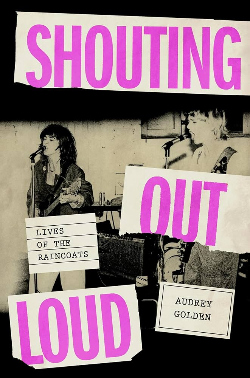 For almost 50 years, The Raincoats have had something of a fragmentary existence: forming, disintegrating, and reforming only to disintegrate then resurface once again. Indeed, the very first iteration of the band was only around long enough to come up with the name and take some photos together before breaking up. So to piece it all together for a definitive biography is no mean feat. But that’s exactly what Audrey Golden, an American writer who previously penned I Heard You Speak: Women at Factory Records, has attempted with Shouting Out Loud: Lives of The Raincoats (Da Capo).
For almost 50 years, The Raincoats have had something of a fragmentary existence: forming, disintegrating, and reforming only to disintegrate then resurface once again. Indeed, the very first iteration of the band was only around long enough to come up with the name and take some photos together before breaking up. So to piece it all together for a definitive biography is no mean feat. But that’s exactly what Audrey Golden, an American writer who previously penned I Heard You Speak: Women at Factory Records, has attempted with Shouting Out Loud: Lives of The Raincoats (Da Capo).
Following an intro by Greil Marcus, a longtime champion of the band who wrote the liner notes for The Kitchen Tapes, The Raincoats’ live album from 1983, Golden lays out her approach to the book:
The many lives of The Raincoats have been propelled by the band’s commitment to experimentation and evolving forms of collaboration. The research for this book is an extension of that spirit. In writing it, I sought to use new forms of narrative writing to bring together overlapping stories of and about the band into a single chronicle that reflects the many facets of those experiences.
As such, she conducted extensive interviews with not only the principle members of the band, Ana Da Silva and Gina Birch, lifelong manager Shirley O’Loughlin, and the other musicians who have been Raincoats at various times, but nearly anyone of any significance in the band’s story to create a richly layered oral history of what she describes as The Raincoats’ three lives.
Three lives, because as mentioned, the band had three periods of existence. As Golden details, there was the first life that began while Da Silva and Birch were students at Hornsey College of Art, and they decided to form a band after seeing the Sex Pistols and, more importantly, The Slits. Golden details how Hornsey’s history of cultural revolution and Gina’s squat living played important roles in The Raincoats’ gestation, and how it was this life that established The Raincoats as post-punk progenitors. Joined by violinist Vicky Aspinall and former Slits drummer Palmolive, the band recorded and released its seminal self-titled album in 1979. Two more studio albums and The Kitchen Tapes would follow (along with a parade of drummers; The Raincoats needing a drummer is a recurring storyline/punchline in the book) before the band splintered.
Life two began in Olympia, Washington, without The Raincoats’ participation. Golden traces how the music scene revolving around Evergreen State College and its KAOS radio station spurred a cultish interest in the band within the community and eventually led to Kurt Cobain championing the band and to DGC, Nirvana’s major label home, reissuing the band’s catalog. This, in turn, prompted an actual second existence, with The Raincoats reforming and recording a new album for DGC in 1996.
Of course, The Raincoats probably didn’t belong on a major label, and when DGC soured on its second album option, the band fizzled once again. However, as Golden reveals, interest in the band didn’t, and the new wave of riot grrl bands in Olympia and like-minded feminist groups elsewhere continued to be inspired by the band. Here, Golden does a particularly excellent job of connecting all the dots between The Raincoats and those they inspired and how life number two segued into life number three when invitations to play at events like Robert Wyatt’s Meltdown and institutions like the Museum of Modern Art were received. She also expertly shows how The Raincoats’ work has not only been reexamined as serious art and contextualized from a feminist point of view, but also how songs like their take on The Kinks’ “Lola” were part of a dialogue with the queer community as well.
What Golden does best, though, is exactly what she set out to do. Her interviews with everyone from Rough Trade’s Geoff Travis to the members of Bikini Kill, Sonic Youth, Sleater-Kinney, and more are expertly woven throughout her history of the band to offer insight and emphasize how the band’s legacy touched so many people in so many facets, while her quotes from the band themselves are often revelatory. Moreover, just as she suggests when detailing how she listened only to the band’s music while writing the book, the narrative follows an idiosyncratic rhythm not unlike those Palmolive laid down on the first record, with tangents explored and disparate points of view represented, which makes the book particularly reflective of its subject matter and ultimately a richly, rewarding and endlessly fascinating read.

Your Comments